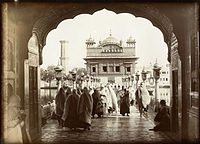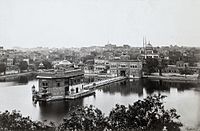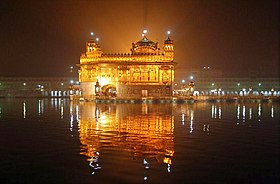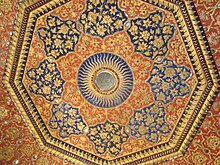http://en.wikipedia.org/wiki/Harmandir_Sahib
Harmandir Sahib
From Wikipedia, the free encyclopedia
| The Harmandir Sahib ਹਰਿਮੰਦਰ ਸਾਹਿਬ The Golden Temple | |
|---|---|

| |
| General information | |
| Architectural style | Sikh architecture |
| Town or city | Amritsar |
| Country | India |
| Coordinates | 31°37′12″N 74°52′37″ECoordinates: 31°37′12″N 74°52′37″E |
| Construction started | December 1585 AD |
| Completed | August 1604 |
The Harmandir Sahib (Punjabi: ਹਰਿਮੰਦਰ ਸਾਹਿਬ), also Darbar Sahib (Punjabi: ਦਰਬਾਰ ਸਾਹਿਬ, Punjabi pronunciation: [dəɾbɑɾ sɑhɪb])[1][3] and informally referred to as the "Golden Temple",[1] is a prominent SikhGurdwara located in the city of Amritsar, Punjab, India. It was built by the fourth Sikh guru, Guru Ramdaas Sahib Ji, in the 16th Century. In 1604, Guru Arjun completed the Adi Granth, the holy scripture of Sikhism, and installed it in the Gurudwara.[4]
There are four doors to get into the Harmandir Sahib, which symbolize the openness of the Sikhs towards all people and religions.[5] The present day Gurdwara was rebuilt in 1764 by Jassa Singh Ahluwalia with the help of other SikhMisls. In the early nineteenth century, Maharaja Ranjit Singh secured the Punjab region from outside attack and covered the upper floors of the Gurdwara with gold, which gives it its distinctive appearance and its English name.[4]
The Harimandir Sahib is considered holy by Sikhs. The holiest text of Sikhism, the Guru Granth Sahib,[6] is always present inside the Gurdwara. Its construction was mainly intended to build a place of worship for men and women from all walks of life and all religions to come and worship God equally.[1][6][6] Over 100,000 people visit the holy shrine daily for worship.[7]
Contents
[hide]History[edit]
The Harmandir Sahib literally means The Temple of God. The fourth guru of Sikhs, Guru Ram Das, excavated a tank in 1577 CE which subsequently became known as Amritsar (meaning "Pool of the Nectar of Immortality"),[8] giving its name to the city that grew around it. In due course, a Sikh edifice, Sri Harmandir Sahib (meaning "the abode of God"),[9] rose in the middle of this tank and became the supreme centre of Sikhism. Its sanctum came to house the Adi Granth comprising compositions of Sikh Gurus and other saints considered to have Sikh values and philosophies, e.g., Baba Farid, and Kabir. The compilation of The Adi Granth was started by the fifth guru of Sikhism, Guru Arjan Dev Ji.
Construction of the Harmandir Sahib[edit]
Sri Guru Arjan Sahib, the Fifth Sikh Guru, conceived the idea of creating a central place of worship for the Sikhs and he himself designed the architecture of Sri Harmandir Sahib. Earlier the planning to excavate the holy tank (Amritsar or Amrit Sarovar ) was chalked out by Guru Amar Das Ji, the Third Sikh Guru, but it was executed by Guru Ramdas Sahib under the supervision of Baba Budha ji. The land for the site was acquired by the earlier Guru Sahibs on payment or free of cost from the Zamindars (landlords) of native villages. The plan to establish a town settlement was also made. Therefore, the construction work on the Sarovar(the tank) and the town started simultaneously in 1570. The work on both projects completed in 1577 A.D. During the leadership of the fifth Guru, Guru Arjan (1581–1606), the full-fledged Gurdwara was built. In December 1588, Guru Arjan initiated the construction of the Gurdwara. The foundation stone was laid by none other than Guru Arjan Sahib himself in December 1588. It is a common misconception that the foundation stone was laid by the Sufi saint Mian Mir of Lahore.[10][11][12][13][14][15]
Some of the architectural features of the Harmandir Sahib were intended to be symbolic of the Sikh worldview.[16]Instead of the normal custom of building a Gurdwara on high land, it was built at a lower level than the surrounding land so that devotees would have to go down steps to enter it.[16] In addition, instead of one entrance, Sri Harmandir Sahib has four entrances.[16]
The Gurdwara was completed in 1604. Guru Arjan, installed the Guru Granth Sahib in it and appointed Baba Buddha as the first Granthi (reader) of it on August 1604. In the mid-18th century it was attacked by the Afghans, by one of Ahmed Shah Abdali's generals, Jahan Khan, and had to be substantially rebuilt in the 1760s. However, in response a Sikh Army was sent to hunt down the Afghan force. Both forces met each other five miles outside Amritsar; Jahan Khan's army was destroyed.[17][17]
The Harmandir Sahib Complex and areas in its vicinity[edit]
| This section does not cite any references or sources. (July 2013) |
The Gurdwara is surrounded by a large lake or holy tank, known as the Sarovar, which consists of Amrit ("holy water" or "immortal nectar") and is fed by the Ravi River. There are four entrances to the Gurdwara, signifying the importance of acceptance and openness. Inside the Gurdwara complex there are many shrines to past Sikh Gurus, saints and martyrs (see map). There are three holy trees (bers), each signifying a historical event or Sikh saint. Inside the Gurdwara there are many memorial plaques that commemorate past Sikh historical events, saints, martyrs and includes commemorative inscriptions of all the Sikh soldiers who died fighting in World Wars I and II.
In keeping with the rule observed at all Sikh Gurdwaras worldwide, the Harmandir Sahib is open to all persons regardless of their religion, colour, creed, or sex. The only restrictions on the Harmandir Sahib's visitors concern their behavior when entering and while visiting:
- Maintaining the purity of the sacred space and of one's body while in it:
- Upon entering the premises, removing one's shoes (leaving them off for the duration of one's visit) and washing one's feet in the small pool of water provided;
- Not drinking alcohol, eating meat, or smoking cigarettes or other drugs while in the shrine
- Dressing appropriately:
- Wearing a head covering (a sign of respect) (the Gurdwara provides head scarves for visitors who have not brought a suitable covering);[18]
- Not wearing shoes (see above).
- How to act:
- If you choose to listen to Gurbani, one must also sit on the ground while in the Darbar Sahib as a sign of deference to both the Guru Granth Sahib and God.
First-time visitors are advised to begin their visit at the information office and then proceed to the Central Sikh Museum near the main entrance and clock tower.[tone]
The Harimandir Sahib runs one of the largest free kitchens in the world, serving 100,000 people on average daily.[19] The meal consists of flat bread and lentil soup.[19]
Artwork and monument sculptures[edit]
Much of the present decorative gilding and marblework dates from the early 19th century. All the gold and exquisite marble work were conducted under the patronage of Hukam Singh Chimni and Emperor Ranjit Singh, Maharaja of the Sikh Empire of the Punjab. The Darshani Deorhi Arch stands at the beginning of the causeway to the Harmandir Sahib; it is 62 metres (203 ft) high and 6 metres (20 ft) in width. The gold plating on the Harmandir Sahib was begun by Ranjit Singh and was finished in 1830.Maharaja Ranjit Singh was a major donor of wealth and materials for the shrine and is remembered with much affection by the Punjabi people in general and the Sikh community in particular.[citation needed]
Celebrations at the Harmandir Sahib[edit]
One of the most important festivals is Vaisakhi, which is celebrated in the second week of April (usually the 13th). Sikhs celebrate the founding of the Khalsa on this day and it is celebrated with fervour in the Harmandir Sahib. Other important Sikh religious days such as the martyrdom day of Guru Teg Bahadur, the birthday of Guru Nanak, etc., are also celebrated with religious piety. Similarly Bandi Chhor Divas is one of the festivals which sees the Harmandir Sahib beautifully illuminated with Divas (lamps); lights and fireworks are discharged. Most Sikhs visit Amritsar and the Harmandir Sahib at least once during their lifetime, particularly and mostly during special occasions in their life such as birthdays, marriages, childbirth, etc.
Blue Star[edit]
Main article: Operation Blue Star
Blue Star was a military operation undertaken on 3 June 1984 and ended on 6 June 1984. The Indian Army, led by GeneralKuldip Singh Brar, brought infantry, artillery, and tanks into the Harmandir Sahib to put a stop to self-styled Dharam Yudh Morcha led by Bhindrawala. During these "Morchay" thousands of Sikhs courted arrest. Indira Gandhi ordered the army to launch Operation Blue Star. Within six months, Indira Gandhi’s Sikh bodyguards killed her (31 October 1984) for the perceived sacrilege.
Fierce fighting ensued between Sikhs and the soldiers, in which many of the Sikhs were killed along with many soldiers. The Harmandir Sahib complex also suffered much damage due to the attack, especially the holy Akal Takhat Sahib.
This attack is regarded by Sikhs as a desecration of Sikhism's holiest shrine and discrimination against a minority in India. In 1986, the repairs performed on the Akal Takhat Sahib after the attack, which the Rajiv Gandhi Government had undertaken without consultation, were removed. A new Akal Takhat Sahib was completed in 1999 by Kar Sevaks (volunteer labor and funding).


























No comments:
Post a Comment